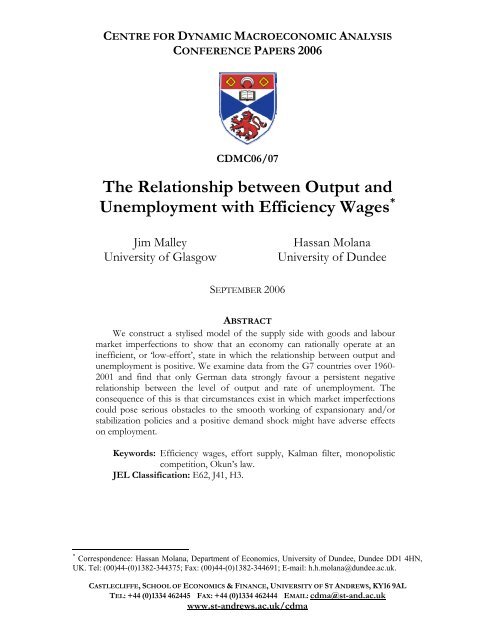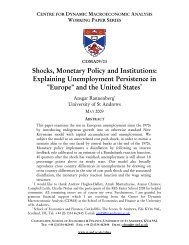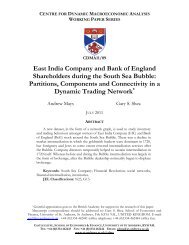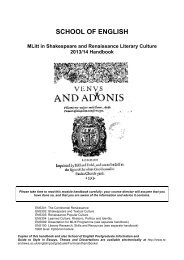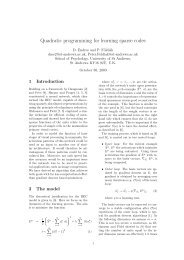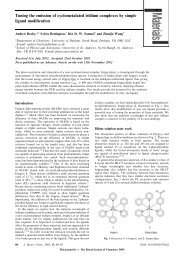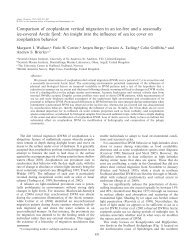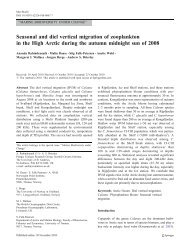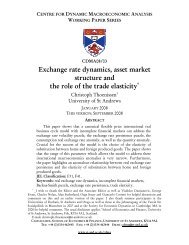The Relationship between Output and ... - ResearchGate
The Relationship between Output and ... - ResearchGate
The Relationship between Output and ... - ResearchGate
You also want an ePaper? Increase the reach of your titles
YUMPU automatically turns print PDFs into web optimized ePapers that Google loves.
CENTRE FOR DYNAMIC MACROECONOMIC ANALYSIS<br />
CONFERENCE PAPERS 2006<br />
CDMC06/07<br />
<strong>The</strong> <strong>Relationship</strong> <strong>between</strong> <strong>Output</strong> <strong>and</strong><br />
Unemployment with Efficiency Wages *<br />
Jim Malley<br />
University of Glasgow<br />
Hassan Molana<br />
University of Dundee<br />
SEPTEMBER 2006<br />
ABSTRACT<br />
We construct a stylised model of the supply side with goods <strong>and</strong> labour<br />
market imperfections to show that an economy can rationally operate at an<br />
inefficient, or ‘low-effort’, state in which the relationship <strong>between</strong> output <strong>and</strong><br />
unemployment is positive. We examine data from the G7 countries over 1960-<br />
2001 <strong>and</strong> find that only German data strongly favour a persistent negative<br />
relationship <strong>between</strong> the level of output <strong>and</strong> rate of unemployment. <strong>The</strong><br />
consequence of this is that circumstances exist in which market imperfections<br />
could pose serious obstacles to the smooth working of expansionary <strong>and</strong>/or<br />
stabilization policies <strong>and</strong> a positive dem<strong>and</strong> shock might have adverse effects<br />
on employment.<br />
Keywords: Efficiency wages, effort supply, Kalman filter, monopolistic<br />
competition, Okun’s law.<br />
JEL Classification: E62, J41, H3.<br />
* Correspondence: Hassan Molana, Department of Economics, University of Dundee, Dundee DD1 4HN,<br />
UK. Tel: (00)44-(0)1382-344375; Fax: (00)44-(0)1382-344691; E-mail: h.h.molana@dundee.ac.uk.<br />
CASTLECLIFFE, SCHOOL OF ECONOMICS & FINANCE, UNIVERSITY OF ST ANDREWS, KY16 9AL<br />
TEL: +44 (0)1334 462445 FAX: +44 (0)1334 462444 EMAIL: cdma@st-<strong>and</strong>.ac.uk<br />
www.st-<strong>and</strong>rews.ac.uk/cdma
1. Introduction<br />
In the last few decades, industrialised nations have been subjected to a variety of external <strong>and</strong><br />
policy-induced dem<strong>and</strong> shocks while simultaneously experiencing significant changes in<br />
their labour productivity <strong>and</strong> employment. Meanwhile, governments have been concerned to<br />
maintain a balance <strong>between</strong> implementing those policies which protect workers against job<br />
losses (to reduce the hardship of unemployment) <strong>and</strong> those which restrain the unemployment<br />
rate. However, as Lindbeck (1992) warns, unless we have a clear underst<strong>and</strong>ing of how such<br />
policies work, their implementation may produce unexpected consequences: "In the context<br />
of a nonmarket-clearing labour market, it is certainly reasonable to regard unemployment, in<br />
particular highly persistent unemployment, as a major macroeconomic distortion. <strong>The</strong>re is<br />
therefore a potential case for policy actions, provided such actions do not create more<br />
problems than they solve. Experience in many countries suggests that the latter reservation is<br />
not trivial."<br />
In this paper we focus on one such case by examining the relationship <strong>between</strong> the<br />
level of output <strong>and</strong> the rate of unemployment. <strong>The</strong> common belief regarding this relationship<br />
is dominated by Okun’s Law which predicts that a fall in output growth is normally<br />
accompanied by a significant but smaller rise in unemployment. This prediction <strong>and</strong> its<br />
policy implications are straightforward when output <strong>and</strong> unemployment exhibit a systematic<br />
negative relationship with each other beyond trend <strong>and</strong> cyclical variations. However, they<br />
are not so clear if these variables happen to be positively related. We therefore ask whether<br />
there are circumstances in which a rise in the rate of unemployment can lead to an increase<br />
the level of output, <strong>and</strong> develop a theoretical model that shows such a result can be obtained<br />
when labour <strong>and</strong> goods markets operate under certain (plausible) conditions 1 . <strong>The</strong> model<br />
allows for a distortion in the labour market through incorporating a variant of the efficiency<br />
wage hypothesis whereby involuntary unemployment gives rise to externalities that could be<br />
exploited by economic agents; price-setting firms use high or rising unemployment as a<br />
device to deter shirking. <strong>The</strong> novelty of the variant used in this paper is that, unlike the<br />
existing models in which a worker’s effort level is discrete <strong>and</strong> can assume either a low or a<br />
high value, it allows a worker’s optimal effort supply to be a continuous function of its<br />
determinants. <strong>The</strong>se determinants are: (i) the net of tax income from employment relative to<br />
1<br />
Clearly, such departures from st<strong>and</strong>ard results are expected when models deviate from perfectly competitive<br />
conditions by allowing for some type of rigidity or distortion, e.g. efficiency wages, unionisation, wage<br />
contracts, unemployment insurance, etc. For instance, Acemoglu <strong>and</strong> Shimer (2000) focus on the effect of<br />
raising unemployment insurance within a search model <strong>and</strong> conclude that more generous welfare<br />
programmes can in fact raise output <strong>and</strong> welfare despite giving rise to a higher unemployment.<br />
1
the unemployment benefit; <strong>and</strong> (ii) rate of unemployment in the economy. In such<br />
circumstances the supply side is shown to exhibit a non-linearity which is adequately<br />
captured by a humped-shape relationship <strong>between</strong> output <strong>and</strong> unemployment rate. It follows<br />
that the economy can, at any point in time, be in one of the three possible states with regard<br />
to the effort level. <strong>The</strong> st<strong>and</strong>ard case, in line with Okun’s Law in which output <strong>and</strong><br />
unemployment rate are negatively related, occurs in the ‘high-effort’ state where the<br />
economy can be said to be operating ‘efficiently’. In this case, to raise the level of output in<br />
response to a rise in aggregate dem<strong>and</strong> firms need to employ more workers. <strong>The</strong> opposite<br />
case occurs in the ‘low-effort’ state in which the economy may be said to be operating<br />
‘inefficiently’. In this situation a higher level of output can be achieved at a lower level of<br />
employment since firms find it more profitable to meet the rise in dem<strong>and</strong> by inducing the<br />
workers to raise their (optimal) effort supply. <strong>The</strong>se two states are separated by a third, the<br />
‘threshold effort’ state, which corresponds to the peak of the humped-shaped relationship<br />
where the combination of employment <strong>and</strong> effort yields the maximum level of output. In this<br />
sense, therefore, in the threshold effort state the economy may be said to be operating without<br />
any slack despite the existence of a positive level of involuntary unemployment 2 .<br />
To explore the extent to which the non-linearity predicted by the model is supported<br />
by evidence, we examine the relationship <strong>between</strong> unemployment rate <strong>and</strong> level of output<br />
using data from the G7 countries. Our empirical analysis is based on estimating a state space<br />
‘local linear trend’ model using the Kalman-filter. This approach allows us to account both<br />
for secular <strong>and</strong> cyclical variations <strong>and</strong> for changes in productivity of other factors, which do<br />
not explicitly feature in the analysis. Our evidence suggests that whilst low-effort periods<br />
have occurred significantly within the sample, periods corresponding to threshold effort seem<br />
to dominate <strong>and</strong> only German data shows a strong support for more frequent occurrence of<br />
the high-effort case.<br />
<strong>The</strong> rest of the paper proceeds as follows. Section 2 outlines the model <strong>and</strong> shows<br />
how the non-linearity described above emerges. Section 3 explains our econometric method<br />
<strong>and</strong> reports the evidence for each of the G7 countries <strong>and</strong> Section 4 concludes the paper. <strong>The</strong><br />
Appendix outlines the derivation of the effort function used in this paper.<br />
2<br />
Other recent studies which examine the link <strong>between</strong> unemployment <strong>and</strong> productivity include Malley <strong>and</strong><br />
Moutos (2001), Daveri <strong>and</strong> Tabellini (2000), Blanchard (1998), Caballero <strong>and</strong> Hammour (1998a,b), Gordon<br />
(1997a) <strong>and</strong> Manning (1992). However, none of these studies explores the link <strong>between</strong> unemployment <strong>and</strong><br />
output arising from both labour <strong>and</strong> product market imperfections.<br />
2
2. <strong>The</strong> <strong>Relationship</strong> <strong>between</strong> <strong>Output</strong> <strong>and</strong> Unemployment: <strong>The</strong>ory<br />
<strong>The</strong> main purpose of this paper is to throw light on the interpretation of Okun’s law with<br />
emphasis on the relationship <strong>between</strong> output <strong>and</strong> unemployment on the supply side of the<br />
economy. More precisely, we wish to focus on the structural relationship <strong>between</strong> output <strong>and</strong><br />
unemployment implied by the supply side when there are goods <strong>and</strong> labour market<br />
imperfection, <strong>and</strong> examine how such a relationship fits in with the general observation that<br />
output <strong>and</strong> unemployment are related to each other negatively beyond trend <strong>and</strong> cyclical<br />
variations. In this section, therefore, we use the efficiency wage hypothesis to provide a<br />
simple theoretical explanation of the way output Y <strong>and</strong> unemployment rate u are likely to be<br />
related on the supply side. Before outlining the theoretical model, however, it is helpful<br />
highlight the problem by considering at the outset the temporal aggregate production function<br />
which may be simplified to focus on the variables of interest, namely<br />
Y = Y ( q,<br />
L);<br />
Y′ > 0, Y′ > 0,<br />
(1)<br />
q<br />
L<br />
which, at any point in time, traces the combinations of aggregate employment L <strong>and</strong> output Y<br />
for the corresponding level of labour productivity q. Now, invoking the assumption that q is,<br />
ceteris paribus, determined by the level of workers’ effort <strong>and</strong> postulating that workers’<br />
effort supply is positively related to the unemployment rate − i.e. the higher is u the larger is<br />
the effort supplied <strong>and</strong> hence dq/du>0; see, for example, Shapiro <strong>and</strong> Stiglitz (1984) − we<br />
can use<br />
dY dq dL<br />
= Y ′<br />
q<br />
+ Y ′<br />
L<br />
, (2)<br />
du du du<br />
to deduce the behaviour of sign of dY/du as u varies in the positive unit interval. In<br />
particular, because dL/du< 0 by definition, the relationship <strong>between</strong> Y <strong>and</strong> u on the temporal<br />
production function would resemble that depicted in Figure 1 below if, at very low levels of<br />
u, Y′ ( dq/ du)<br />
is sufficiently large <strong>and</strong> dominates Y′ ( dL/ du)<br />
so as to make dY/du> 0. In<br />
q<br />
other words, it is possible that dY/du changes from negative to positive as the unemployment<br />
rate falls below a certain threshold, u . In such circumstances, the interpretation of Okun’s<br />
law <strong>and</strong> its consequences for macroeconomic policy differ drastically depending on the<br />
prevailing rate of actual unemployment in relation to the threshold level u . That is, unless<br />
u > u<br />
, the observation that a fall in Y is accompanied by a rise in u (<strong>and</strong> hence Okun’s law<br />
holds) could only have been caused by a shift in the temporal production function down<br />
<strong>and</strong>/or to the right. As a result, the st<strong>and</strong>ard macroeconomic policies are unlikely to yield the<br />
L<br />
3
expected results as stressed by Lindbeck (1992). More specifically, it is not certain that an<br />
exogenous stimulation of aggregate dem<strong>and</strong> would lead to a reduction in unemployment.<br />
Y<br />
Figure 1. <strong>The</strong> temporal relationship <strong>between</strong><br />
output <strong>and</strong> unemployment<br />
Y<br />
0← u u u→1<br />
To illustrate that Figure 1 depicts a plausible theoretical aggregate supply under the<br />
efficiency wage hypothesis, below we develop a basic model building on the work of Shapiro<br />
<strong>and</strong> Stiglitz (1984) <strong>and</strong> Yellen (1984). A number of studies have employed some version of<br />
the efficiency wage hypothesis to examine various aspects of macroeconomic activity.<br />
Examples can found in: Agénor <strong>and</strong> Aizenman (1999) <strong>and</strong> Rebitzer <strong>and</strong> Taylor (1995) on<br />
fiscal <strong>and</strong> labour market policies; Andersen <strong>and</strong> Rasmussen (1999), Pisauro (1991) <strong>and</strong><br />
Carter (1999) on the role of the tax system; Leamer (1999) on specialisation; Albrecht <strong>and</strong><br />
Vroman (1996), Fehr (1991) <strong>and</strong> Smidt-Sørensen (1990) on properties of labour dem<strong>and</strong>; <strong>and</strong><br />
Smidt-Sørensen (1991) on working hours. In this paper we employ a st<strong>and</strong>ard version of the<br />
hypothesis which postulates that workers adjust their effort supply in response to the net<br />
income they earn from employment relative to the benefit rate they receive when<br />
unemployed, <strong>and</strong> to the threat of losing their job <strong>and</strong> remaining unemployed. But rather than<br />
using a discrete choice <strong>between</strong> low <strong>and</strong> high effort levels we allow for the optimal effort<br />
supply to be a continuous function of its determinants.<br />
Consider an economy in which the product market structure is monopolistically<br />
competitive <strong>and</strong> output is a CES bundle of varieties of a horizontally differentiated product.<br />
Thus, dem<strong>and</strong> for each variety j is<br />
−s<br />
⎛ p<br />
j ⎞<br />
yj<br />
Y P<br />
= ⎜ ⎟<br />
⎝ ⎠<br />
, (3)<br />
where y j <strong>and</strong> p j are quantity dem<strong>and</strong>ed <strong>and</strong> price of the variety, s>1 is the elasticity of<br />
substitution <strong>between</strong> any two varieties, <strong>and</strong> Y <strong>and</strong> P are the real aggregate dem<strong>and</strong> <strong>and</strong> the<br />
4
corresponding price level, respectively. <strong>The</strong> latter are determined by the CES aggregators<br />
below where N is the mass of available varieties 3 ,<br />
Y<br />
1/[1−(1/<br />
s)]<br />
⎛ ⎞<br />
1−(1/<br />
s)<br />
= ⎜ y j<br />
dj⎟<br />
⎜ ∫ , (4)<br />
⎟<br />
⎝ j∈N<br />
⎠<br />
1/(1−<br />
s)<br />
⎛ ⎞<br />
1−s<br />
P = ⎜ p j<br />
dj⎟<br />
⎜ ∫ . (5)<br />
⎟<br />
⎝ j∈N<br />
⎠<br />
Suppose that each firm produces one variety of the good using labour as the only<br />
input with an increasing returns to scale technology whose labour requirement in efficiency<br />
units is given by<br />
el<br />
j j<br />
= λ + y , (6)<br />
j<br />
where l<br />
j<br />
is quantity of labour input, e<br />
j<br />
is labour productivity <strong>and</strong> λ is a constant parameter<br />
reflecting the fixed cost of production (assumed to be identical across firms). <strong>The</strong> increasing<br />
returns to scale, implied by falling average cost, therefore gives rise to the incentive for full<br />
specialisation from which a one-to-one correspondence <strong>between</strong> the mass of varieties <strong>and</strong><br />
firms results.<br />
We assume that labour is homogeneous <strong>and</strong> is perfectly mobile <strong>between</strong> firms. A<br />
worker employed by firm j earns nominal wage<br />
w<br />
j<br />
<strong>and</strong> pays tax t, <strong>and</strong> the government<br />
provides an unemployment insurance scheme which pays b to each unemployed worker. We<br />
also assume that workers’ productivity is determined by their attitude towards shirking. In<br />
particular,<br />
e<br />
j<br />
is assumed to represent the optimal effort supply of a typical worker which<br />
depends on: (i) the difference <strong>between</strong> net real wage <strong>and</strong> unemployment benefit,<br />
ω<br />
j<br />
= ( wj<br />
−t− b)/<br />
P; <strong>and</strong> (ii) the extent of unemployment in the economy captured by the<br />
unemployment rate u. We postulate the following effort supply function for a worker<br />
employed by firm j (an example of this type of effort supply function, which satisfies the<br />
following properties <strong>and</strong> is obtained when workers maximise their expected utility from<br />
work, is explicitly derived in Appendix A1)<br />
e<br />
j<br />
= e( ω , u)<br />
, (7)<br />
j<br />
which is assumed to satisfy the following properties (subscript j is dropped):<br />
3<br />
Normalising the CES bundle by the mass of varieties N to switch off the variety effect in the aggregate, as,<br />
for example, in Blanchard <strong>and</strong> Kiyotaki (1987), does not affect the results.<br />
5
(1) e( ω , u)<br />
> 0 as ω > 0, u > 0 ; e ( ω,<br />
u)<br />
= 0 ∀u<br />
∈(0,1)<br />
as ω = 0 ; <strong>and</strong><br />
e( ω , u)<br />
→ 0 ∀ω<br />
> 0 as u → 0<br />
(2) e is increasing in both ω <strong>and</strong> u: = ∂ e ∂ e<br />
e ω > 0 ; e = > 0<br />
∂ ω<br />
u<br />
; <strong>and</strong><br />
∂ u<br />
(3) e has plausible second <strong>and</strong> cross partial derivatives. In particular, we shall assume that<br />
2<br />
2<br />
2<br />
= ∂ e<br />
∂ e<br />
∂ e<br />
e<br />
ω ω<br />
< 0 <strong>and</strong> e = > 0<br />
2<br />
∂ ω<br />
ω u<br />
always hold while e u u<br />
= > 0 when u is very<br />
∂ ω<br />
2<br />
∂u<br />
∂ u<br />
close to zero <strong>and</strong> e is very low.<br />
Each firm takes P, Y, N, u, t <strong>and</strong> b as given <strong>and</strong> chooses its ‘efficiency wage’<br />
w<br />
j<br />
<strong>and</strong><br />
price<br />
p<br />
j<br />
so as to maximise its profit<br />
π = p y − w l , (8)<br />
j<br />
j<br />
j<br />
j<br />
j<br />
subject to the dem<strong>and</strong> function in (3) <strong>and</strong> the labour requirement function in (6), as well as<br />
taking account of its workers’ reaction to the choice of<br />
w<br />
j<br />
which is given by the effort<br />
function in (7). <strong>The</strong> first order conditions are ∂ π / ∂ = 0 <strong>and</strong> ∂ π / ∂ = 0 whose<br />
j<br />
w j<br />
j<br />
p j<br />
solution imply the following wage <strong>and</strong> price setting rules 4<br />
Pe<br />
j<br />
w<br />
j<br />
= , (9)<br />
∂e<br />
/ ∂ω<br />
j<br />
p<br />
j<br />
σ w<br />
j<br />
= , (10)<br />
e<br />
j<br />
where σ = s/(s – 1). Equation (9) is a well-known result in the efficiency wage literature <strong>and</strong><br />
implies that firm raises its wage rate up to the point where the effort function is unit elastic in<br />
real wage. Equation (10) is the usual mark-up pricing rule for a monopolistically competitive<br />
firm. In a symmetric equilibrium where all firms are identical, we drop the subscript j <strong>and</strong><br />
write the above equations as<br />
e = ( w/<br />
P)<br />
, (9´)<br />
e ω<br />
e = σ ( w/<br />
P)<br />
, (10´)<br />
4<br />
2<br />
2<br />
<strong>The</strong> second order conditions are satisfied as long as s>1 <strong>and</strong> ∂ e / ∂ω<br />
< 0 .<br />
j<br />
6
Totally differentiating (7), (9´) <strong>and</strong> (10´) with respect to the endogenous variables e,<br />
w/P, t/P, <strong>and</strong> u, taking account of ω = ( w−t− b)/<br />
P, <strong>and</strong> solving the resulting equations we<br />
obtain (see Appendix A2 for details of derivation)<br />
de<br />
du<br />
σ eω<br />
u<br />
= eu − . (11)<br />
e<br />
ω ω<br />
Thus, under our assumptions regarding the shape of the effort function, (11) implies that<br />
de/du>0 always holds, which is consistent with the theoretical consensus that the net result of<br />
an increase in unemployment rate is to raise workers’ effort level. We can use this result to<br />
examine the way in which equilibrium output <strong>and</strong> unemployment are related to each other on<br />
the supply side in the aggregate. Using the definition of aggregate supply <strong>and</strong> imposing<br />
symmetry, the aggregate production function is<br />
Y<br />
where<br />
= ∫ y<br />
jdj<br />
= eL − Nλ , (12)<br />
j∈N<br />
∫<br />
L = L j<br />
dj is total employment. Equation (12) traces the combinations of aggregate<br />
j∈N<br />
employment <strong>and</strong> output in the short-run − i.e. (L,Y) for any given number of firms N − which<br />
satisfy the supply side equilibrium in which labour productivity is determined by an effort<br />
supply function <strong>and</strong> firms pay wages to induces workers to supply the effort level that<br />
maximises their profits. Or, put differently, these combinations of L <strong>and</strong> Y give the<br />
equilibrium locus that describes how Y changes as workers respond to changes in u while the<br />
firms adjust their wage <strong>and</strong> price to ensure the resulting effort supply <strong>and</strong> quantity produced<br />
maximise profits.<br />
Given that L= LF(1 − u)<br />
, where is LF labour force, <strong>and</strong> treating LF, N <strong>and</strong> λ as<br />
exogenous 5 , from (12) we obtain<br />
dY<br />
du<br />
de<br />
∝ ( 1−<br />
u)<br />
− e . (13)<br />
du<br />
Thus, provided that de/du, which is given by equation (11), is finite as u → 1, we would<br />
expect the right-h<strong>and</strong>-side of (13) to be negative for sufficiently large levels of u.<br />
Conversely, starting from sufficiently low levels of u, we would expect the right-h<strong>and</strong>-side of<br />
(13) to be positive as long as de/du is positive, as explained above. Given these <strong>and</strong><br />
5<br />
N is endogenous in the long-run whereby free entry <strong>and</strong> exit determine N such that profits are eliminated. It<br />
is easy to verify that the imposition of the long-run equilibrium does not affect the shape of the relationship<br />
<strong>between</strong> aggregate supply <strong>and</strong> unemployment rate derived here.<br />
7
assuming that de/du in (11) is continuous in u, the equilibrium locus in (u, Y) space will be<br />
similar to that illustrated in Figure 1 above.<br />
<strong>The</strong> main implication of the above model that we wish to stress is that it results in a<br />
change in dY/du from negative to positive as unemployment rate falls below a certain<br />
threshold,<br />
Y = Y<br />
u = u<br />
. This is the rate of unemployment at which output attains its highest level,<br />
. At such a point, the economy may be said to be operating without any slack despite<br />
supporting a level of unemployment. Within the region where<br />
u > u<br />
, output <strong>and</strong><br />
unemployment rate are negatively related <strong>and</strong> there is no conflict the implications of Okun’s<br />
Law. This situation corresponds to the high-effort state where the economy can be said to be<br />
operating efficiently <strong>and</strong> firms will have to employ more workers to meet a rise in aggregate<br />
dem<strong>and</strong>. In contrast, the region where u < u corresponds to the low-effort state in which the<br />
economy may be said to be operating inefficiently. In this situation a higher level of output<br />
can be achieved at a lower level of employment since firms will find it more profitable to<br />
meet the rise in dem<strong>and</strong> by inducing the workers to raise their (optimal) effort supply. Thus,<br />
the fact that Okun’s law holds − in that a fall in Y is seen to be accompanied by a rise in u −<br />
when<br />
u ≤ u ought to be the result of shifts in the temporal production function, which could<br />
have adverse consequences for the effectiveness of aggregate dem<strong>and</strong> policies.<br />
3. Evidence<br />
In this section we examine data on the level of output <strong>and</strong> the rate of unemployment from G7<br />
countries – Canada, France, Germany, Italy, Japan, UK <strong>and</strong> US − in order to check whether<br />
evidence supports the existence of a nonlinear relationship such as that in Figure 1. More<br />
specifically, we have explored the strength of evidence to address the following questions:<br />
(i)<br />
Does an ‘inversed U-shape’ specification adequately explain the way output is<br />
related to unemployment rate at any point in time? If so, then,<br />
(ii) how does the actual rate of unemployment intertemporally compare with the<br />
threshold rate of unemployment which separates low-effort from high-effort<br />
states of production <strong>and</strong> corresponds to peak output?<br />
To tackle this task, we have estimated a state space ‘local linear trend’ model using<br />
the Kalman-filter approach . <strong>The</strong> regression model consists of the measurement equation,<br />
Y<br />
t<br />
= α + φ u + δ u + ε , (14)<br />
t<br />
t<br />
t<br />
t<br />
2<br />
t<br />
t<br />
8
which assumes that output is a quadratic function 6 of the unemployment rate subject to an<br />
2<br />
additive stationary r<strong>and</strong>om disturbance term ε iidn( 0, σ )<br />
parameters ( α φ , δ )<br />
t<br />
t<br />
t<br />
t<br />
~<br />
ε<br />
, while allowing the (state)<br />
, to evolve r<strong>and</strong>omly according to appropriate transition equations<br />
which we assume to be as follows<br />
α<br />
t<br />
= α<br />
t 1<br />
+ β<br />
t−1<br />
+ ζ<br />
t<br />
; ζ<br />
t<br />
~ iidn ,<br />
ζ<br />
2<br />
( 0 σ )<br />
2<br />
( 0, σ<br />
ξ<br />
),<br />
0 < 1<br />
2<br />
( 0 σ )<br />
2<br />
( 0 σ )<br />
−<br />
, (15)<br />
β<br />
t<br />
= θβt− 1<br />
+ ξt<br />
; ξt<br />
~ iidn<br />
θ < , (16)<br />
φ = −<br />
, (17)<br />
t<br />
φt<br />
1<br />
+ ηt<br />
; ηt<br />
~ iidn ,<br />
η<br />
δ = −<br />
. (18)<br />
t<br />
δ<br />
t 1<br />
+ ψ<br />
t<br />
; ψ<br />
t<br />
~ iidn ,<br />
ψ<br />
<strong>The</strong> generality allowed by this set up is particularly useful when it is applied to bivariate<br />
relationships which both: (a) involve variables that have strong secular pattern <strong>and</strong>/or are<br />
subject to cyclical fluctuations 7 ; <strong>and</strong> (b) are, by construction, restricted <strong>and</strong> fail to condition<br />
explicitly on a host of other potentially relevant variables 8 . <strong>The</strong> state-space representations,<br />
in this context, are very flexible since the non-stationary processes generating φ t<br />
<strong>and</strong> δ<br />
t<br />
are<br />
allowed to evolve in a manner capable of capturing any fundamental changes, which may<br />
have occurred in the historical relationship <strong>between</strong> Y t <strong>and</strong> u t . Moreover, to account for<br />
trends in output growth <strong>and</strong> the unemployment rate over our estimation period (1960-2001),<br />
we have allowed for local linear trends where both the level, αt<br />
− 1<br />
<strong>and</strong> the slope, βt<br />
− 1<br />
vary<br />
over time 9 . To estimate (14) allowing for (15)-(18), we require starting values for the state<br />
vector <strong>and</strong> its variance-covariance matrix, ( , β , φ δ )<br />
α<br />
0 0 0,<br />
0<br />
<strong>and</strong><br />
0<br />
Σ . In the absence of any<br />
6<br />
7<br />
8<br />
9<br />
While there are a wide variety of alternative non-linear functions capable of capturing the non-monotonic<br />
link <strong>between</strong> Y t <strong>and</strong> u t predicted by our theory, we have opted for the simplest <strong>and</strong> most parsimonious of<br />
these.<br />
Both output <strong>and</strong> unemployment have these properties <strong>and</strong> the estimation method adopted here is a superior<br />
alternative to isolating the secular <strong>and</strong> cyclical components by filtering the series before checking how they<br />
relate to each other over time.<br />
In the absence of any explicit dynamics, we employ contemporaneous values of both output <strong>and</strong> the<br />
unemployment rate. This approach might reasonably be expected to yield biased parameter estimates, given<br />
the joint endogenity of the variables. To assess the extent of this bias we also experimented with IV <strong>and</strong><br />
GMM estimation <strong>and</strong> found any biases to be quantitatively negligible. To preserve space, these latter results<br />
are not reported here but will be made available on request.<br />
Note that in contrast to the other parameters which follow r<strong>and</strong>om walks, β t<br />
is assumed to follow a<br />
stationary AR(1) process. This assumption is employed since a non-stationary process for this parameter<br />
would imply Y t ~ I(2). This, however, is against the widely acknowledged stylised fact that the growth rate of<br />
output is stationary, which is also supported by our data set. For example, univariate evidence based on<br />
ADF, weighted-symmetric <strong>and</strong> Phillips-Perron tests suggest that y t has only one unit root (this evidence is not<br />
presented here but will be make available on request).<br />
9
prior information on the initial distribution 10 , we have employed a diffuse prior which<br />
involves setting the starting values of the coefficients equal to zero <strong>and</strong> letting<br />
Σ = where I is the conformable unit matrix <strong>and</strong> κ is a very large number (see Harvey,<br />
0<br />
κI<br />
1989, for detail).<br />
Empirical support for our theory, within the context of the questions (i) <strong>and</strong> (ii) posed<br />
above, at the beginning of this section, requires that:<br />
(i)′<br />
φ<br />
t<br />
must be significantly greater than zero, δ t<br />
must be significantly less than<br />
zero, the estimated residuals, εˆ t<br />
, must be stationary, <strong>and</strong> the threshold rate of<br />
unemployment, denoted by u t<br />
<strong>and</strong> given by ut<br />
= φt<br />
/( −2δ<br />
t<br />
) from the quadratic<br />
function in (14), should be significantly greater than zero.<br />
(ii)′ Evidence should indicate that in addition to u<br />
t<br />
> ut<br />
, u<br />
t<br />
= ut<br />
<strong>and</strong> u<br />
t<br />
< ut<br />
have<br />
also occurred significantly over the sample period.<br />
To examine these, we obtained filtered estimates of the state vector for each of the G7<br />
countries. Data are quarterly over the period 1960:Q1-2001:Q1 <strong>and</strong> the results are reported<br />
in Table 1 below. Columns (I), (III) <strong>and</strong> (V) give, respectively, the filtered estimates of φ t<br />
,<br />
δ<br />
t<br />
<strong>and</strong> the implied threshold rate of unemployment<br />
ut<br />
= −φ / 2δ<br />
, for the final observation<br />
t<br />
t<br />
(t=T). Columns (II), (IV) <strong>and</strong> (VI) report, respectively, the proportion of observations over<br />
the estimation period for which the null hypotheses φ > 0 , δ < 0 <strong>and</strong> u > 0 cannot be<br />
rejected at the 5% critical level. <strong>The</strong>se results, together with the satisfactory behaviour of the<br />
estimated residuals εˆ<br />
t<br />
(st<strong>and</strong>ard tests not reported here but available on request), suggest that<br />
the quadratic specification in which the peak output occurs at a plausible level of<br />
unemployment is consistent with data, beyond any co- <strong>and</strong>/or counter-movements due to<br />
secular <strong>and</strong>/or cyclical patterns in the underlying series. Moreover, since for each t one of the<br />
three cases u<br />
t<br />
> ut<br />
, u<br />
t<br />
= ut<br />
or u<br />
t<br />
< ut<br />
will have to hold, it is helpful to compare the actual <strong>and</strong><br />
the estimated threshold levels of unemployment. Table 2 below reports the percentage of<br />
significant occurrences of these cases at 5% <strong>and</strong> at 10% critical levels. According to the<br />
results only German data provides a strong support for<br />
t<br />
t<br />
t<br />
t<br />
u > u ; US, Canada, Italy <strong>and</strong> Japan<br />
t<br />
fully reject<br />
u > u while UK <strong>and</strong> to a much lesser extent France show a mild tendency<br />
t<br />
t<br />
towards exhibiting<br />
u > u .<br />
t<br />
t<br />
10 Given that three of the four transition equations are non-stationary, the unconditional distribution of the state<br />
vector is not defined.<br />
10
Table 1. Selected results from estimation of equation (14)<br />
based on quarterly 1964-2001 data for G7 countries<br />
(I) (II) (III) (IV) (V) (VI)<br />
φˆ φ<br />
t<br />
> 0 δˆ δ<br />
t<br />
> 0 û u<br />
t<br />
> 0<br />
T<br />
US<br />
2.49<br />
-0.250<br />
5.62<br />
100%<br />
100%<br />
(0.232)<br />
(0.036)<br />
(1.21)<br />
100%<br />
Canada<br />
2.26<br />
-0.124<br />
9.14<br />
100%<br />
100%<br />
(0.223)<br />
(0.022)<br />
(2.26)<br />
92%<br />
UK<br />
2.47<br />
-0.158*<br />
8.02*<br />
100%<br />
100%<br />
(0.640)<br />
(0.178)<br />
(5.03)<br />
95%<br />
France<br />
4.73<br />
-0.258<br />
9.13<br />
100%<br />
100%<br />
(0.776)<br />
(0.124)<br />
(2.13)<br />
80%<br />
Germany<br />
21.06<br />
-2.47<br />
4.26<br />
100%<br />
100%<br />
(4.60)<br />
(0.593)<br />
(0.07)<br />
100%<br />
Italy<br />
4.75<br />
-0.224<br />
10.58<br />
100%<br />
100%<br />
(0.560)<br />
(0.082)<br />
(2.77)<br />
98%<br />
Japan<br />
4.26<br />
-0.585<br />
3.65<br />
100%<br />
96%<br />
(1.04)<br />
(0.231)<br />
(0.59)<br />
85%<br />
(1) French data do not start until 1964:Q4. <strong>The</strong> initial 4 years (16 observations) were used to<br />
allow the filtered estimates sufficient time to stabilise <strong>and</strong> were excluded in obtaining<br />
estimates in this table. <strong>The</strong> local linear trend components were not significant for German<br />
data <strong>and</strong> hence were excluded in final estimation for that country.<br />
(2) <strong>The</strong> statistical significances of ˆt φ <strong>and</strong> ˆt δ in columns (I) <strong>and</strong> (III) are based on their<br />
asymptotic st<strong>and</strong>ard errors (the numbers in parentheses). An asterisk indicates not<br />
significant at the 5% level. To assess the statistical significance of u ˆt on a period-byperiod<br />
basis we have conducted a parametric bootstrap using 2000 replications for each<br />
quarter. <strong>The</strong> numbers is parentheses are the bootstrapped st<strong>and</strong>ard errors for the final<br />
period. An asterisk indicates not significant at the 5% level.<br />
T<br />
t<br />
Table 2. Comparison <strong>between</strong> the actual <strong>and</strong> threshold levels of unemployment<br />
proportion of u<br />
t<br />
< ut<br />
proportion of u<br />
t<br />
= ut<br />
proportion of u<br />
t<br />
> ut<br />
sig. at 5% sig. at 10% sig. at 5% sig. at 10% sig. at 5% sig. at 10%<br />
US<br />
Canada<br />
UK<br />
France<br />
Germany<br />
Italy<br />
Japan<br />
0.09<br />
0.05<br />
0.01<br />
0.00<br />
0.19<br />
0.00<br />
0.00<br />
0.20<br />
0.09<br />
0.03<br />
0.00<br />
0.19<br />
0.00<br />
0.01<br />
0.91<br />
0.95<br />
0.77<br />
0.94<br />
0.01<br />
1.00<br />
1.00<br />
0.77<br />
0.91<br />
0.71<br />
0.75<br />
0.01<br />
1.00<br />
0.99<br />
0.00<br />
0.00<br />
0.22<br />
0.06<br />
0.80<br />
0.00<br />
0.00<br />
0.03<br />
0.00<br />
0.26<br />
0.25<br />
0.80<br />
0.00<br />
0.00<br />
<strong>The</strong> above evidence is also in line with the findings reported by studies that have<br />
examined the behaviour of labour productivity in connection with employment <strong>and</strong> output in<br />
the industrialised countries <strong>and</strong> provide evidence on the way in which labour productivity has<br />
changed over the last few decades. Recent examples include Disney, et al. (2000), Barnes<br />
11
<strong>and</strong> Haskel (2000), Marini <strong>and</strong> Scaramozzino (2000), van Ark et al. (2000) <strong>and</strong> Sala-i-Martin<br />
(1996). <strong>The</strong> evidence provided in these studies is usually interpreted using either direct<br />
causes − which are the st<strong>and</strong>ard reasons for productivity gains, i.e. i) improved skill due to<br />
training; ii) increased efficiency due to progress in management <strong>and</strong> restructuring; <strong>and</strong> iii)<br />
rising physical productivity of other factors of production due to R&D, etc. − or the indirect<br />
causes whereby market forces induce a rise in efficiency that is needed in order for the firms<br />
to survive competition <strong>and</strong> market selection. <strong>The</strong> separating line <strong>between</strong> these two accounts,<br />
however, is not very clear in the sense that the latter will have to be achieved through the<br />
former when the economy is operating efficiently. But if the economy happens to be in an<br />
inefficient phase, market forces can act directly without having to induce any of the factors in<br />
the first category. <strong>The</strong> efficiency wage hypothesis argument used in this paper is a typical<br />
example of this case. Moreover, given our definition of the threshold rate of unemployment<br />
− that separates the efficient <strong>and</strong> inefficient phases of production − <strong>and</strong> the evidence in Table<br />
2 above that in a number of countries the actual unemployment rate has a tendency to<br />
coincide with a time varying estimate of such a threshold rate, exploring the links <strong>between</strong><br />
this concept <strong>and</strong> the time-varying NAIRU − for example as that studied by Gordon (1997b) −<br />
can throw light on the determination of the natural rate of output <strong>and</strong> hence provides an<br />
interesting direction for future research.<br />
4. Summary <strong>and</strong> Conclusions<br />
<strong>The</strong> main motivating factor underlying our study has been the fact that in some circumstances<br />
a positive policy shock might give rise to adverse employment effects. We have develop a<br />
model which shows that if firms can use the threat of unemployment to induce workers to<br />
supply more effort, the supply side relationship <strong>between</strong> aggregate output <strong>and</strong> unemployment<br />
rate will be non-monotonic. In particular, these variables can be positively related if the gain<br />
in productivity is sufficiently large to outweigh the negative effect of the reduction in<br />
employment. In such circumstances, an expansionary policy will have an adverse effect on<br />
unemployment. Our evidence, based on data from G7 countries over the period 1960-2001,<br />
shows strong support for the non-monotonicity implied by our model. Using an estimation<br />
method which allows for trends, cyclical changes <strong>and</strong> breaks, we find that only German data<br />
strongly favour a persistent negative relationship <strong>between</strong> the level of output <strong>and</strong> rate of<br />
unemployment.<br />
12
Clearly, our results – which complement those of the literature on the effects of<br />
contractionary fiscal policy (Barry <strong>and</strong> Devereux, 1995) <strong>and</strong> on the positive effects of<br />
unemployment insurance (Acemoglu <strong>and</strong> Shimer, 2000) – suggest that plausible<br />
circumstances do exist in which market imperfections pose serious obstacles to the smooth<br />
working of expansionary <strong>and</strong>/or stabilization policies.<br />
13
5. References<br />
Acemoglu, D. <strong>and</strong> R. Shimer (2000), Productivity gains from unemployment insurance,<br />
European Economic Review, 44, 1195-1224.<br />
Agénor, P-R <strong>and</strong> J. Aizenman (1999), Macroeconomic adjustment with segmented labor<br />
markets, Journal of Development Economics, 58, 277-296.<br />
Albrecht, J.W <strong>and</strong> S.B. Vroman (1996), A note on the long-run properties of the shirking<br />
model, Labour Economics, 3, 189-195.<br />
Andersen, T.M. <strong>and</strong> B.S. Rasmussen (1999), Efforts, taxation <strong>and</strong> unemployment, Economics<br />
Letters, 62, 97-103.<br />
Barnes, M. <strong>and</strong> J. Haskel (2000), Productivity in the 1990s: evidence from British plants,<br />
mimeo.<br />
Barry, F. <strong>and</strong> M. Devereux (1995), <strong>The</strong> ‘expansionary fiscal contraction’ hypothesis: a neo-<br />
Keynesian analysis, Oxford Economic Papers, 47, 249-264.<br />
Blanchard, O.J. <strong>and</strong> N. Kiyotaki (1987), Monopolistic competition <strong>and</strong> the effects of<br />
aggregate dem<strong>and</strong>, American Economic Review, 77, 647-66.<br />
Blanchard, O.J. (1998), Revisiting European unemployment: unemployment, capital<br />
accumulation <strong>and</strong> factor prices, mimeo, (MIT).<br />
Caballero, R. <strong>and</strong> M.L. Hammour (1998a), Jobless growth: appropriability, factor<br />
substitution, <strong>and</strong> unemployment. Carnegie-Rochester Series on Public Policy, 48, 51-94.<br />
Caballero, R. <strong>and</strong> M.L. Hammour (1998b), <strong>The</strong> macroeconomics of specificity, Journal of<br />
Political Economy, 103, 724-767.<br />
Carter, T.J. (1999), <strong>The</strong> effect of taxes on labour in efficiency wage models: a comment,<br />
Journal of Public Economics, 72, 325-327.<br />
Daveri, F. <strong>and</strong> G. Tabellini (2000), Unemployment, growth <strong>and</strong> taxation in industrial<br />
countries, Economic Policy, 30, 47-88.<br />
Disney, R., Haskel, J. <strong>and</strong> Y. Helden (2000), Restructuring <strong>and</strong> productivity growth in UK<br />
manufacturing, mimeo.<br />
Fehr, E. (1991), Wages <strong>and</strong> labor dem<strong>and</strong>: a note, Journal of Institutional <strong>and</strong> <strong>The</strong>oretical<br />
Economics, 147, 539-546.<br />
Gordon, R. (1997a), Is there a trade-off <strong>between</strong> unemployment <strong>and</strong> productivity growth? in<br />
Snower, D. <strong>and</strong> G. de la Dehesa (eds), Unemployment policy: government options for<br />
the labour market (1997), Cambridge University Press, Cambridge, pp4333-463.<br />
Gordon, R. (1997b), Time varying NIRU <strong>and</strong> its implications for economic policy, Journal of<br />
Economic Perspectives, 11, 11-32.<br />
14
Harvey, A. (1989), Forecasting, structural time series models <strong>and</strong> the Kalman filter,<br />
Cambridge University Press, Cambridge.<br />
Leamer, E.E. (1999), Efforts, wages, <strong>and</strong> the international division of labour, Journal of<br />
Political Economy, 107, 1127-1162.<br />
Lindbeck, A. (1992), Macroeconomic theory <strong>and</strong> the labour market, European Economic<br />
Review, 36, 209-235.<br />
Malley, J. <strong>and</strong> T. Moutos (2001), Capital accumulation <strong>and</strong> unemployment: a tale of two<br />
continents, Sc<strong>and</strong>inavian Journal of Economics, 103, 79-99.<br />
Manning, A. (1992), Productivity growth, wage setting <strong>and</strong> the equilibriun rate of<br />
unemployment, Centre for Economic Performance, Discussion paper No 63.<br />
Marini G. <strong>and</strong> P. Scaramozzino (2000), Endogenous growth <strong>and</strong> social security, CeFiMS DP<br />
02/00/02, Centre for Financial <strong>and</strong> Management Studies, SOAS, University of London<br />
Pisauro, G. (1991), <strong>The</strong> effect of taxes on labour in efficiency wage models, Journal of Public<br />
Economics, 46, 329-345.<br />
Rebitzer, J.B. <strong>and</strong> L.J. Taylor (1995), <strong>The</strong> consequences of minimum wage laws; some new<br />
theoretical ideas, Journal of Public Economics, 56, 245-255.<br />
Sala-i-Martin, X.X. (1996), A positive theory of social security, Journal of Economic<br />
Growth, 1, 277-304.<br />
Shapiro, C. <strong>and</strong> J.E. Stiglitz (1984), Equilibrium unemployment as a worker discipline<br />
device, American Economic Review, 74: 433-44.<br />
Smidt-Sørensen, J.B. (1990), <strong>The</strong> equilibrium effort-wage elasticity in efficiency-wage<br />
models, Economics Letters, 32, 365-369.<br />
Smidt-Sørensen, J.B. (1991), An efficiency-wage-hours model <strong>and</strong> shorter working hours,<br />
Scottish Journal of Political Economy, 38, 113-131.<br />
van Ark, B., Kuipers, S., <strong>and</strong> G. Kuper (2000), Productivity, Technology <strong>and</strong> Economic<br />
Growth, Kluwer Academic Publishers.<br />
Yellen, J.L. (1984), Efficiency wage models of unemployment, American Economic Review,<br />
74, 200-205.<br />
15
6. Appendix<br />
A1. Derivation of the Effort Supply Function, e(ω, u)<br />
This appendix explains how a specific effort supply function such as that in equation (7) can<br />
be derived within the framework of the efficiency wage hypothesis where, following<br />
common practice, the agent (consumer/worker) is assumed to maximise the expected utility<br />
of remaining in employment.<br />
We assume that all agents participate in the labour market <strong>and</strong> at any point in time an<br />
individual agent can be in one of the following states: (i) employed (working); (ii) being fired<br />
(when caught shirking at work); (iii) unemployed (being without a job); or (iv) being hired<br />
(finding a job). Let the utility indices corresponding to the above states be denoted as<br />
follows:<br />
(i)<br />
employed (working): V E<br />
(ii) being fired (losing one’s job): V F<br />
(iii) unemployed (being without a job): V U<br />
(iv) being hired (finding a job): V H<br />
It is straightforward to derive V U <strong>and</strong> V E . For simplicity, here we approximate these<br />
by the indirect utility of a typical agent at any point in time, which can be written as<br />
() e<br />
V = m − λ ⋅ f . m is the real disposable income of the agent from work; normalising the<br />
price level P to unity, m= w− t (net of tax real wage) <strong>and</strong> m= b (real benefit) for employed<br />
<strong>and</strong> unemployed agents, respectively. <strong>The</strong> function () e ≥ 0<br />
f captures the disutility of effort<br />
e; λ=1 <strong>and</strong> λ= 0 for employed <strong>and</strong> unemployed agents, respectively, <strong>and</strong> we assume that<br />
f ′ > 0 <strong>and</strong> f ′′ ≥ 0 which imply that the disutility of effort rises with a non-decreasing rate.<br />
For simplicity, <strong>and</strong> without loss of generality, we shall use the explicit form<br />
f ( e)<br />
= ke<br />
2<br />
where k>0 is a scaling factor. Thus,<br />
V U = b , (A1.1)<br />
V E<br />
=<br />
2<br />
( w − t) − ke<br />
. (A1.2)<br />
We assume that V H , which is the satisfaction a consumer attaches to finding a job or<br />
being hired is in principle not distinguishable from V E <strong>and</strong> for simplicity we let<br />
V H = V E .<br />
(A1.3)<br />
<strong>The</strong> probabilities associated with moving from one state to another are assumed to be<br />
determined as follows:<br />
16
(a) Probability associated with being fired when shirking, F.<br />
We assume that shirking is the only reason for being fired (we do not explicitly model the<br />
monitoring technology). <strong>The</strong>refore, ceteris paribus, F is a monotonic function of the effort<br />
level, e. Thus,<br />
() e ; F() 0 = 1; F() 1 = 0; ′ < 0<br />
F = F<br />
F .<br />
For simplicity, normalise the maximum possible effort to unity <strong>and</strong> let<br />
F = 1 – e.<br />
(A1.4)<br />
(b) Probability associated with finding a job, or being hired, when unemployed, H.<br />
We assume that the labour force is homogeneous <strong>and</strong>, ceteris paribus, H is a monotonic<br />
function of the unemployment rate, u (we do not explicitly model the search technology).<br />
Thus,<br />
( u) ; H ( 0) ≤1;<br />
H ( 1) = 0; ′ < 0<br />
H = H<br />
H .<br />
For simplicity we let<br />
H = 1 – u.<br />
(A1.5)<br />
We define the optimal level of effort as that which maximises a household’s expected<br />
utility of remaining in employment. <strong>The</strong> latter is denoted by R(e) <strong>and</strong> is, by definition, given<br />
by<br />
R(e) = (1 – F)V E + FV F .<br />
(A1.6)<br />
Also, given that a ‘fired’ worker can either be hired or remain unemployed, we let V F be a<br />
weighted average of V H <strong>and</strong> V U . Thus,<br />
V F = HV H + (1 – H)V U .<br />
(A1.7)<br />
Equations (A1)-(A7) yield<br />
((1<br />
− u)(<br />
w − t ub)<br />
3<br />
2<br />
R ( e)<br />
= −uke<br />
− (1 − u)<br />
ke + u(<br />
w − t − b)<br />
e +<br />
) +<br />
. (A1.8)<br />
<strong>The</strong> agent takes (w, t, b, u) as given <strong>and</strong> chooses e to maximise R(e). <strong>The</strong> first order<br />
− e<br />
−<br />
− u<br />
u e +<br />
w − t − b<br />
2<br />
condition for this is ((2/3)(1<br />
) / ) ( 1/3 )(<br />
) 0<br />
k<br />
=<br />
. This has two roots of<br />
which only one is positive, which also satisfies the second order for a maximum <strong>and</strong> can,<br />
after some normalisation, be written as<br />
1<br />
2<br />
2<br />
⎡ ⎛1−<br />
u ⎞ ⎤ 1−<br />
u<br />
e = e(<br />
ω , u)<br />
= ⎢γω<br />
+ ⎜ ⎟ ⎥ − , (A1.9)<br />
⎢⎣<br />
⎝ u ⎠ ⎥⎦<br />
u<br />
17
where ω = (w - t - b) <strong>and</strong> γ ≡ 3/k. It is clear that equation (A1.9) satisfies our specified<br />
conditions since e ( ω,<br />
u)<br />
= 0 ∀u<br />
∈(0,1)<br />
as ω = 0 ; e ( ω,<br />
u)<br />
> 0 as ω > 0 ; e > 0 ;<br />
e > 0 ; e < 0 ; e ω<br />
> 0 ; <strong>and</strong> e > 0 for small values of u, as required.<br />
u<br />
ω ω<br />
u<br />
u u<br />
ω<br />
A2. Derivation of Equations (11).<br />
Equation (11) is derived from equations (7), (9´) <strong>and</strong> (10´) <strong>and</strong> the definition<br />
ω<br />
j<br />
= ( wj<br />
−t− b)/<br />
P, which are reproduced below as (A2.1)-(A2.4), respectively, where we<br />
have normalised P = 1 <strong>and</strong> dropped subscript j.<br />
e = e( ω,<br />
u)<br />
, (A2.1)<br />
e = we ω<br />
, (A2.2)<br />
e = σ w, (A2.3)<br />
ω = w − t − b . (A2.4)<br />
Totally differentiating the above, treating e, ω, u, w <strong>and</strong> t as endogenous (note that t ought to<br />
be treated as endogenous when the government fixes b since variations in u can cause a<br />
budget deficit or surplus), we obtain<br />
( dw−<br />
dt) + eudu<br />
dw + w e ( dw − dt)<br />
de = e ω , (A2.5)<br />
( e du)<br />
de = e<br />
, (A2.6)<br />
ω ω ω<br />
+<br />
ω u<br />
de = σ dw, (A2.7)<br />
dω = dw − dt . (A2.8)<br />
Given that (A2.2) <strong>and</strong> (A2.3) imply e<br />
ω<br />
= σ , (A2.7) can be used to write (A2.5) <strong>and</strong> (A2.6) as<br />
<strong>and</strong><br />
−σ dt + e du = 0 , (A2.9)<br />
u<br />
( dw − dt) + e du = 0<br />
eω ω<br />
ω<br />
. (A2.10)<br />
Solving these yields<br />
dt<br />
du<br />
<strong>and</strong><br />
eu<br />
= σ<br />
u<br />
> 0 , (A2.11)<br />
dw e e<br />
u ω u<br />
= − > 0 . (A2.12)<br />
du σ e<br />
ω ω<br />
de σ eω<br />
u<br />
Finally, using (A2.7) <strong>and</strong> (A2.12) we obtain = e − > 0<br />
du e<br />
u<br />
.<br />
ω ω<br />
18
www.st-<strong>and</strong>.ac.uk/cdma<br />
ABOUT THE CDMA<br />
<strong>The</strong> Centre for Dynamic Macroeconomic Analysis was established by a direct<br />
grant from the University of St Andrews in 2003. <strong>The</strong> Centre funds PhD students <strong>and</strong><br />
facilitates a programme of research centred on macroeconomic theory <strong>and</strong> policy. <strong>The</strong><br />
Centre has research interests in areas such as: characterising the key stylised facts of<br />
the business cycle; constructing theoretical models that can match these business<br />
cycles; using theoretical models to underst<strong>and</strong> the normative <strong>and</strong> positive aspects of<br />
the macroeconomic policymakers' stabilisation problem, in both open <strong>and</strong> closed<br />
economies; underst<strong>and</strong>ing the conduct of monetary/macroeconomic policy in the UK<br />
<strong>and</strong> other countries; analyzing the impact of globalization <strong>and</strong> policy reform on the<br />
macroeconomy; <strong>and</strong> analyzing the impact of financial factors on the long-run growth<br />
of the UK economy, from both an historical <strong>and</strong> a theoretical perspective. <strong>The</strong> Centre<br />
also has interests in developing numerical techniques for analyzing dynamic stochastic<br />
general equilibrium models. Its affiliated members are Faculty members at St Andrews<br />
<strong>and</strong> elsewhere with interests in the broad area of dynamic macroeconomics. Its<br />
international Advisory Board comprises a group of leading macroeconomists <strong>and</strong>, ex<br />
officio, the University's Principal.<br />
Affiliated Members of the School<br />
Dr Arnab Bhattacharjee.<br />
Dr Tatiana Damjanovic.<br />
Dr Vladislav Damjanovic.<br />
Dr Laurence Lasselle.<br />
Dr Peter Macmillan.<br />
Prof Kaushik Mitra.<br />
Prof Charles Nolan (Director).<br />
Dr Gary Shea.<br />
Prof Alan Sutherl<strong>and</strong>.<br />
Dr Christoph Thoenissen.<br />
Senior Research Fellow<br />
Prof Andrew Hughes Hallett, Professor of<br />
Economics, V<strong>and</strong>erbilt University.<br />
Research Affiliates<br />
Prof Keith Blackburn, Manchester University.<br />
Prof David Cobham, Heriot-Watt University.<br />
Dr Luisa Corrado, Università degli Studi di Roma.<br />
Prof Huw Dixon, York University.<br />
Dr Anthony Garratt, Birkbeck College London.<br />
Dr Sugata Ghosh, Brunel University.<br />
Dr Aditya Goenka, Essex University.<br />
Dr Campbell Leith, Glasgow University.<br />
Dr Richard Mash, New College, Oxford.<br />
Prof Patrick Minford, Cardiff Business School.<br />
Dr Gulcin Ozkan, York University.<br />
Prof Joe Pearlman, London Metropolitan<br />
University.<br />
Prof Neil Rankin, Warwick University.<br />
Prof Lucio Sarno, Warwick University.<br />
Prof Eric Schaling, R<strong>and</strong> Afrikaans University.<br />
Prof Peter N. Smith, York University.<br />
Dr Frank Smets, European Central Bank.<br />
Dr Robert Sollis, Durham University.<br />
Dr Peter Tinsley, George Washington University<br />
<strong>and</strong> Federal Reserve Board.<br />
Dr Mark Weder, University of Adelaide.<br />
Research Associates<br />
Mr Nikola Bokan.<br />
Mr Michal Horvath.<br />
Ms Elisa Newby.<br />
Mr Qi Sun.<br />
Mr Alex Trew.<br />
Advisory Board<br />
Prof Sumru Altug, Koç University.<br />
Prof V V Chari, Minnesota University.<br />
Prof John Driffill, Birkbeck College London.<br />
Dr Sean Holly, Director of the Department of<br />
Applied Economics, Cambridge University.<br />
Prof Seppo Honkapohja, Cambridge University.<br />
Dr Brian Lang, Principal of St Andrews University.<br />
Prof Anton Muscatelli, Glasgow University.<br />
Prof Charles Nolan, St Andrews University.<br />
Prof Peter Sinclair, Birmingham University <strong>and</strong><br />
Bank of Engl<strong>and</strong>.<br />
Prof Stephen J Turnovsky, Washington University.<br />
Mr Martin Weale, CBE, Director of the National<br />
Institute of Economic <strong>and</strong> Social Research.<br />
Prof Michael Wickens, York University.<br />
Prof Simon Wren-Lewis, Exeter University.
www.st-<strong>and</strong>.ac.uk/cdma<br />
THE CDMA CONFERENCE 2006, held in St. Andrews, 6th to the 8th of September 2006.<br />
PAPERS PRESENTED AT THE CONFERENCE, IN ORDER OF PRESENTATION:<br />
Title<br />
Author(s) (presenter(s) in bold)<br />
Underst<strong>and</strong>ing the Macroeconomics of Oil<br />
Caution of Activism? Monetary Policy<br />
Strategies in an Open Economy<br />
Interest Rate Smoothing <strong>and</strong> Monetary Policy<br />
Activism in the Bank of Engl<strong>and</strong>, the ECB<br />
<strong>and</strong> the Fed<br />
Linear-Quadratic Approximation, Efficiency<br />
<strong>and</strong> Target-Implementability<br />
<strong>The</strong> <strong>Relationship</strong> <strong>between</strong> <strong>Output</strong> <strong>and</strong><br />
Unemployment with Efficiency Wages<br />
Underst<strong>and</strong>ing Labour Market FrictionsL A<br />
Tobin’s Q Approach<br />
Money Velocity in an Endogenous Growth<br />
Business Cycle with Credit Shocks<br />
Partial Contracts<br />
Optimal Fiscal Feedbak on Debt in an<br />
Economy with Nominal Rigidities<br />
Inflation Targeting: Is the NKM fit for<br />
purpose?<br />
Testing a Simple Structural Model of<br />
Endogenous Growth<br />
<strong>The</strong> Optimal Monetary Policy Response to<br />
Exchange Rate Misalignments<br />
Labor Contracts, Equal Treatment <strong>and</strong> Wage-<br />
Unemployment Dynamics<br />
Peter Sinclair (Birminham)<br />
Martin Ellison (Warwick <strong>and</strong> CEPR), Lucio<br />
Sarno (Warwick BS <strong>and</strong> CEPR) <strong>and</strong> Juoko<br />
Vilmunen (Bank of Finl<strong>and</strong>)<br />
David Cobham (Heriot-Watt)<br />
Paul Levine (Surrey), Joseph Pearlman (London<br />
Metropolitan) <strong>and</strong> Richard Pierse (Surrey)<br />
Jim Malley (Glasgow) <strong>and</strong> Hassan Molana<br />
(Dundee)<br />
Parantap Basu (Durham)<br />
Szilárd Benk (Magyar Nemzeti Bank <strong>and</strong> Central<br />
European University), Max Gillman (Cardiff<br />
<strong>and</strong> Hungarian Academy of Sciences) <strong>and</strong><br />
Michal Kejak (CERGE-EI)<br />
Oliver Hart (Harvard) <strong>and</strong> John Hardman<br />
Moore (Edinburgh <strong>and</strong> LSE)<br />
Tatiana Kirsanova (Exeter) <strong>and</strong> Simon Wren-<br />
Lewis (Exeter)<br />
Peter N. Smith (York) <strong>and</strong> Mike Wickens (York)<br />
Patrick Minford (Cardiff <strong>and</strong> CEPR), David<br />
Meenagh (Cardiff) <strong>and</strong> Jiang Wang (Cardiff)<br />
Cambell Leith (Glasgow) <strong>and</strong> Simon Wren-<br />
Lewis (Exeter)<br />
Andy Snell (Edinburgh) <strong>and</strong> Jonathan Thomas<br />
(Edinburgh)<br />
See also the CDMA Working Paper series at www.st-<strong>and</strong>rews.ac.uk/cdma/papers.html.


